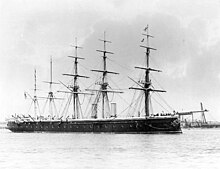Channel Fleet
| Channel Fleet | |
|---|---|

British ironclad HMS Minotaur as Channel Fleet flagship, c. 1875-1887.
|
|
| Active | 1690-1909 |
| Country |
|
| Branch |
|
| Type | Fleet |
| Garrison/HQ | Torbay, Falmouth and Plymouth. |
The Channel Fleet was the Royal Navy formation of warships that defended the waters of the English Channel from 1690 to 1909.
The Channel Fleet dates back at least to 1690 when its role was to defend England against the French threat under the leadership of Edward Russell, 1st Earl of Orford who was then the Commander-in-Chief, Channel Fleet. By 1801 its main role was still to stop French ships from the French naval bases at Brest, Le Havre and elsewhere in the Bay of Biscay from entering the English Channel.
During the 19th century, as the French developed Cherbourg as a base for steam-powered ships, the Royal Navy developed Portland Harbour as a base for the fleet. The harbour was built between 1849 and 1872 when the Royal Navy created a breakwater made of blocks from local quarries on the Isle of Portland. The Channel Squadron only became a permanent formation in 1858.
With the amelioration of Anglo-French relations, and the rise of German militarism towards 1900, the need for the Channel Fleet diminished and the main European naval arena shifted to the North Sea.
Admiral Sir Arthur Wilson was officially "Senior Officer in Command of the Channel Squadron" from 1901 to 1903. His subordinate flag officer in that squadron was the Second-in-Command, who commanded a division of battleships. On 14 December 1904 the Channel Fleet was re-styled the 'Atlantic Fleet' and the Home Fleet became the 'Channel Fleet'.
On 24 March 1909, under a fleet re-organisation, the Channel Fleet became the 2nd Division of the Home Fleet.
The Channel Fleet features in several historical novels about the Royal Navy, notably Hornblower and the Hotspur by C. S. Forester, in which Forester's fictional hero becomes a favourite of the real Channel Fleet commander, Admiral William Cornwallis. The fleet also features in several of the Aubrey-Maturin novels by Patrick O'Brian.
...
Wikipedia
